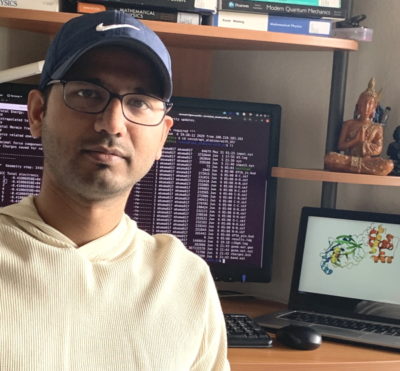Anshuman Kumar is sharpening a digital pencil to penetrate the secrets of the coronavirus.
He and colleagues at the University of California at Riverside want to calculate atomic interactions at a scale never before attempted for the virus. If they succeed, they’ll get a glimpse into how a molecule on the virus binds to a molecule of a drug, preventing it from infecting healthy cells.
Kumar is part of a team at UCR taking work in the tiny world of quantum mechanics to a new level. They aim to measure a so-called barrier height, a measure of the energy required to interact with a viral protein that consists of about 5,000 atoms.
That’s more than 10x the state of the art in the field, which to date has calculated forces of molecules with up to a few hundred atoms.
Accelerating Anti-COVID Drug Discovery
Data on how quantum forces determine the likelihood a virus will bind with a neutralizing molecule, called a ligand, could speed work at pharmaceutical companies seeking drugs to prevent COVID-19.
“At the atomic level, Newtonian forces become irrelevant, so you have to use quantum mechanics because that’s the way nature works,” said Bryan Wong, an associate professor of chemical engineering, materials science and physics at UCR who oversees the project. “We aim to make these calculations fast and efficient with NVIDIA GPUs in Microsoft’s Azure cloud to narrow down our path to a solution.”
Researchers started their work in late April using a protein on the coronavirus believed to play a strong role in rapidly infecting healthy cells. They’re now finishing up a series of preliminary calculations that take up to 10 days each.
The next step, discovering the barrier height, involves even more complex and time-consuming calculations. They could take as long as five weeks for a single protein/ligand pair.
Calling on GPUs in the Azure Cloud
To accelerate time to results, the team got a grant from Microsoft’s AI for Health program through the COVID-19 High Performance Computing Consortium. It included high performance computing on Microsoft’s Azure cloud and assistance from NVIDIA.
Kumar implemented a GPU-accelerated version of the scientific program that handles the quantum calculations. It already runs on the university’s NVIDIA GPU-powered cluster on premises, but the team wanted to move it to the cloud where it could run on V100 Tensor Core GPUs.
In less than a day, Kumar was able to migrate the program to Azure with help from NVIDIA solutions architect Scott McMillan using HPC Container Maker, an open source tool created and maintained by NVIDIA. The tool lets users define a container with a few clicks that identify a program and its key components such as a runtime environment and other dependencies.

It was a big move given the researchers had never used containers or cloud services before.
“The process is very smooth once you identify the correct libraries and dependencies — you just write a script and build the code image,” said Kumar. “After doing this, we got 2-10x speedups on GPUs on Azure compared to our local system,” he added.
NVIDIA helped fine-tune the performance by making sure the code used the latest versions of CUDA and the Magma math library. One specialist dug deep in the stack to update a routine that enabled multi-GPU scaling.
New Teammates and a Mascot
The team got some unexpected help recently when it discovered a separate computational biology lab at UCR also won a grant from the HPC consortium to work on COVID. The lab observes the binding process using statistical sampling techniques to make bindings that are otherwise rare occur more often.
“I reached out to them because pairing up makes for a better project,” said Wong. “They can use the GPU code Anshuman implemented for their enhanced sampling work,” he added.
“I’m really proud to be part of this work because it could help the whole world,” said Kumar.
The team also recently got a mascot. A large squirrel, dubbed Billy, now sits daily outside the window of Wong’s home office, a good symbol for the group’s aim to be fast and agile.
Stay up to date with the latest healthcare news from NVIDIA.
Pictured above: Colorful ribbons represent the Mpro protein believed to have an important role in the replication of the coronavirus. Red strands represent a biological molecule that binds to a ligand. (Image courtesy of UCR.)
